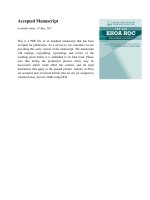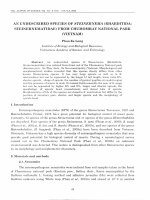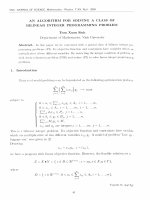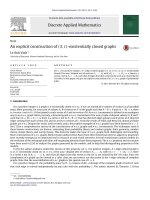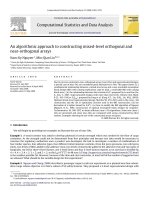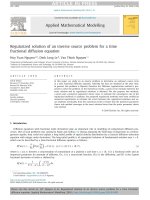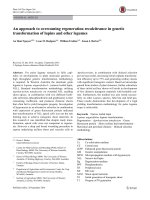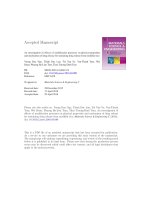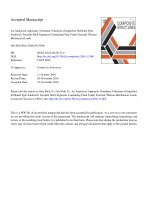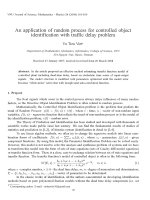DSpace at VNU: An experiment of investigating syntactic behavior of nouns and verbs in Vietnamese in terms of iconicny
Bạn đang xem bản rút gọn của tài liệu. Xem và tải ngay bản đầy đủ của tài liệu tại đây (267.01 KB, 7 trang )
VNU
J O U R N A L O F S C IE N C E ,
soc
. S C I . H U M A N ., N 01E. 2002
\ N E X P E R I M E N T O F IN V K S T IÍỈA T IN ÍỈ S Y N T A C T IC B E H A V I O R O F N O U N S A N D
VKRBS IN V IETNAMESE IN TERMS O F I C O N I C n Y
N guyen V an H ie p (’’
Abstract
are because, like d iagram s, they resem ble the
conceptual structures they are used to convey;
This paper deals with syntactic behavior of
or, that linguistic structures resem ble each
nouns and verbs in Vietnamese. Generally, in our
other because the different conceptual dom ains
language nouns differ from verbs in that they are
they represent are thought in the sam e way"
different in compound with such other words as
những, các, này, no... (as for nouns) or đà, dang,
[12, p. 1]. A rm ed with a special concern, some
sẽ, xong, rói... (as for verbs). However, in some
functional
cases, a noun or a verb may lack these abilities.
research on the Iconicity in language. The
prototypically
or
conducting
be resum ed as
- M anv linguistic universals are tendencies
in Vietnamese are determined by the way they
either
been
following:
syntax, the syntactic behavior of nouns and verbs
used
have
result o f this research can
According to the hypothesis of iconicity in
are
linguists
rather than absolute restrictions;
non-
prototypically. The categories of nouns and verbs
- T he universals c a n be explained.
actually
In
manifest
themselves
only
when
the
discourse requires them to: the less a linguistic
element is required
details,
two
types
of
iconicity
in
language are advanced as hypotheses:
by the discourse either to
+ Isom orphism :
report an discrete discourse event or to introduce
the tendency for there to
be a one-to-one corre sp o n d en c e betw een form
a discrete entity participating in the state of
and m eaning.
affairs, the less saliently it will be marked as verbs
+ M otivation: the reflection in linguistic
or nouns
structure o f som e aspect o f the structure o f
l.T h e iconic features in syntax
reality.
The study o f linguistic universals in the
In the s u m m e r o f 1983, a c onference about
60s m ade m any linguists surprised when they
iconicity in syntax took place in Stanford,
realized that natural lan g u a g e s in the world
gathering
resem ble each other in s o m e aspects. This fact
them , Tai d iscussed the tem poral sequence o f
led them to suspect the so-called arbitrariness
c o m pound
o f language. Som e o b servations show ed that
linearity m anifest o f iconicity, recalling Caesar'
"linguistic forms are frequently the way they
s "veni, vidi, vici". Dealing with so m e reduced
m an y
sentences
Assoc Prof Dr Department of Linguistics. College of Social Sciences & Humanities. VNU
55
fam ous
in
linguists.
C hinese
A m ong
as
one
Nguyen Van Hiep
56
e x p ressions, Cỉivón a rg u e d that
reduced
e x p re s s io n s
of
in principle
describe sentence o f such an isolating language
predictable
as V ietnam ese is to use model T h e m e-R h e m e.
m ore
in form ation is a n icon o f the lesser
attention
Sporadically
som e
c o n ic
aspects
of
paid to su ch in form ation. Bybee m a d e the point
Vietnamese syntax were mentioned such as the
that the c lo se n e ss b e tw e e n a verb stem and
s y m m e try o f proverbs, the role o f ord er of
inflectional
words...
c a te g o rie s
tends
to
reflect
the
relevance o f c o n c e p tu a l c lo s e n e s s that these
H ow ever,
in
V ietnam ese
no
one
officially pays attention to iconicity in syntax.
inflectional c a te g o rie s c a rry to su c h verb stem.
She c o n firm e d that the p ro x im ity o f e lem ents
in a clause follow s s o m e iconic principle w hose
result
is
that
e le m e n ts
g o in g
2. The iconicity in sjntactic behavior of
noun and verb in Vietnamese
together
se m antically tend to o c c u r close to g eth e r in the
In this paper, in term o f iconicity we deal
clause. A .W ie rz b ic k a sh ow ed that se em in g ly
w ith syntactic behavior of nouns and verbs, two
arbitrary
singular/
m ost important parts o f speech in Vietnam ese.
w heat are in fact
T herefore, we w ould like to provide data from
m otivated by a set o f co g n itiv e principles...
an isolating language to confirm the iconic
[12]. In France, m a n y rese a rc h papers with the
aspect o f the tw o parts of speech, which has
sam e spirit w ere colle cte d and pu b lish e d in
b een studied a lot by functional gram m arians
"Faits dc L a n g u e s" N o 1/1993.
in inflectional lan g u a g e s (14].
d istinctions
in
term s
plural b e tw e en oats an d
of
In V ie tn a m e s e g ra m m a r, P h a n N g o c has
Nouns and verbs in V ietnam ese as well as
are
in other languages are two m a jo r classes that
co nsidered as a rg u m e n ts for a n e w app ro a c h to
have sem antic correlation with the two most
g ra m m a r
important c oncepts [11, p.320-321]. As for
sh o w n
so m e
iconic
of
phenom ena
V ie tn a m e s e
that
on
sem antic
principles. F o r e x a m p le , in serial verbs the one
nouns
takes
one
prototypicaiiy like "thing" or "object” and is
d e scrib in g the e a rlie r event (M ời ố n g cỉi lên Ị.lập
considered as "tim e-stability". V erbs, on the
ông
o th er hand, are considered to report something
prec e d in g
g iám
m odifiers
đốc)
or
the
o rd e r
be
of
the
attribute
is
something
d e g re e o f a b stra c tn e ss ( Q u y ể n sá ch lịch sử Việt
are used to sym bolize concepts that lack time-
N am bìa vủm> in ch ừ dò). He m a d e the point
stability. T he distinction be tw e en nouns and
that ignoring that rule w ould c re a te long and
verbs is a linguistic
c u m b e rs o m e se n te n c e s [6, p .2 7 1 -3 0 1 ]. W hile
prevailing all over the world. T h at is why in
strongly criticizing the plausibility o f m odel
V ietnam ese as well as in o th er languages, the
Subject “P redicate
"general m eaning" criterium is often used for
Cao
aspect
is d e te rm in e d
it presents
prototypicaily like "actions" o r "events"; they
iconic
V ie tn a m e s e
will
entity
by
sentences,
in
position
the
for d e s c rib in g
X uan
of
Hao
V ie tn a m ese
m e n tio n e d
V ie tn a m e s e
sy n ta x
universal phenom enon
one
distinguishing nouns and verbs: nouns have
by
general n e a n in g about things or objects, verbs
co n firm in g that the o n ly ap p ro p riate w ay to
have general m e a n in g a b out actions or events.
r . v r
Joirnalof Science, Soc., Sci., Human., S o l E, 2002
An experiment of investigating syntactic behavior.
57
been
'T h e m o re a form refers to a discrete
supported from the form al distinction: If in
d isc o u rs e entity o r reports a d isc re te d iscourse
inflectional languages nouns d iffe r from verbs
event, the m o re distinct will he its linguistic
in trappings on gender, n um ber, tense, aspect,
form
m ood, voice...then in such
p a ra d ig m a tic a lly
I'll is
as
c ontent
V ie tn a m ese
distinction
that
has
isolating languages
nouns
and
verbs
are
different in the way ihev are c o m p o u n d e d with
from
Ly, the list o f "evidential w o r d s ” used for
d istin su ish in g nouns and verbs is c o n firm e d in
alm ost
hooks
about
parts
of
speech
as
following:
a)
and
form s,
both
sy n ta g m a tica lly "
[1 4 ,p. 151]. F o llo w in g from
w hat m en tio n e d
above, the hypothesis seem s to be unchallenged.
another parts o f speech have until now been
agreed by m ost linguists. Initiated by Le V an
n e ig h b o rin g
H o w e v er,
fro m
all o f what
m en tio n e d
abo v e it is a ls o e a sy to realize that th ere is an
e x tre m e
te n d e n c y
s e m a n tic
fea tu re s
reg a rd in g th ese
by
of
focu sin g
nouns
inherent
and
verbs,
features as d e c isiv e
factors
w hich d e te r m in e sy n ta c tic b e h a v io r o f nouns
Such
words
as
and verbs. So rese a rc h e rs m u st be con fu se d
such
w h e n they c o n fro n t the c a se s in that n o uns and
determ iners as "này, ấy, nọ, kia" afte r a noun.
verbs lack the o w n c h a ra c te ristic ability o f
For exam ple,
c o m p o u n d in g . S o m e instances c a n be cited as
"những, c á c ” can
for
plural
he put
m a rk e r
b e fo re
and
"Cúc han ấ y nói c h u y ệ n với nhau suốtfollow ing:
-
n s a y ’TITiesc students are always talking in class).
b) Such function w ords for tense, aspect,
-As for nouns:
-L a c k
of
ability
of
c o m p o u n d in g
as
mood, negation
as "đã, d a n s , sè, k h ô n gc , chảng,
Cr
c
m e n tio n e d in (a), e.g. ability to g o a lo n g with
chưa, cứ. còn..." can be located b e fo re and such
" n h ữ n g ’, "các" (put before) a n d "này", "ấy",
words as "xong, ròi" after a verb. F o r ex a m p le:
"nọ", "kia" (put after) and existence o f tendency
-"Hm tôi chưa làm x ong bài tập" (M y
For e x a m p le : "N gười Việt N a m án d ũ a '\
brother hasn't do n e his h o m e w o rk yet).
The distinction
se m a n tic a lly to inco rp o rate in the prior verb.
has be e n s u p p o rte d
by
(T h e
V ie tn a m e s e
cat
w ith
ch o p stic k s)
"Anil ta làm ruộng" He d o e s the fa rm in g ).W e
m any studies on noun phrases and v e rb phrases
can not say:
in
V ietnam ese.
The
fact
that
g e n e ra lly
in
com paring with a n o th e r parts o f s p e e c h nouns
sharply differ from verbs in term o f syntactic
behavior (for an su c h isolating la n g u a g e as
V ietnam ese it m e a n s the ability to c o m p o u n d
with
another
hypothesis
w ord)
about
the
m ee ts
the
iconicity
follow ing
of
lexical
categories principle:
- Người V iệt N am ăn * n h ữ n g /* c á c dũa
*này.
- A n h ta làm *nhĩfng/*các ruộng *dó.
-L a ck
of
m e n tio n e d
in
a bility
(a)
of
w hile
c o m p o u n d in g
e ith e r
as
playing
attributive role in c o p u la s e n te n c e s (Bỏ tôi là
g iáo viên) (M y fath e r is a tea cher) o r playing
the role o f o b ject in su c h s e n te n c e s in w hich
I \(
Journal of Science. Soc , Sci . Human , \ ,11:, 2002
Nguyen Van Hiep
58
transitive verbs are used in a special w ay as
- L a c k o f ability o f com p o u n d in g
as
"Chị làm ỵ tú đà m ấ y n ã m nay"( She has be e n a
m entioned in (b) while playing the ro le o f
nurse for several years). W e c a n not say:
m o d ifie r to predicate in su c h type o f se n te n c e
as "Chiếc d ồ n g hổ này trông rất đẹp" (T his
- Bô tôi là giáo viên *đó.
w atch looks very nice), "Chuối này àn k h ô n g
- C hị làm V tá *ấy d ã m ấy n ăm nay.
ngon”
- N o u n refe rrin g to a n "attac h e d " body
k in d
o f bananas
don't
taste
d e l i c i o u s ) . W e c a n not say:
part lack ability o f c o m p o u n d in g as m en tio n e d
in (a) w hile go in g a lo n g w ith its o w n e r, as in
(This
- C hiếc đ ồ n g hồ này *đã/?đang/*sẽ trông
rất đẹp.
sentence 'T ô i đau đ ầ u " ( I have a headache),
"Tai nạn làm gây tay nó" ( H e broke his arm in
-Chuối này *đã/*đang/*sẽ ân không ngon.
the accident). W e can not say:
Shortly speaking, in the foregoing study
casesx nouns and verbs in V ie tn a m ese lacked
- T ôi đ a u đầu *này.
- Tai nạn làm gãy *những/*các tay (cúa) nó.
the
characteristic
which
As for verbs:
- Lack
would
be
ability
used
of
as
c o m p o u n d in g ,
criteria
to
their
differentiation.
o f ability
of
c o m p o u n d in g
as
m en tio n e d in (b) w hile play in g the role of
H o w w ould these seem ly odd p h e n o m e n a
be e xplained by linguists?
subject in se n tence, for e x a m p le : "Yêu là chết
W e think that these phe n o m e n a s h o w an
ờ trong lòng m ột ít" ( L ove is blue ), "77?/ dua
là yêu nước" (E m u la tio n is patriotisiin). W e
aspect o f the iconicity in syntax in V ietnam ese,
spectacularly perform ed by nouns and verbs.
ca n not say:
Its nature consists in the distinction betw een
- * Đ ã /* d a n g /* s ẽ yêu là c h ế t ở trong lòng
m ột ít.
- L ack
prototypical/non-
o f ability
o f nouns and verbs. C onsequently, only
o f c o m p o u n d in g
as
m en tio n e d in (b) in the s o -c a lle d existential
se n te n c es, for e x a m p le : " Đ á u làng trồng một
cây đ a to" ( T h e re is a tall tree at th e d g e o f the
'T r ê n
tư ờ ng
treo m ộ t
bức
tranh"
- "Đ á u làng * đ ă /* d a n g /* s ẽ trồiìiị m ộ t cây
đ a to.
a
prototypical noun would be m ax im a lly distinct
from a prototypical verb [15, p.30]. Because
those nouns and verbs in the study c ase are
used non-prototypically so their distinction in
term o f syntactic behavior is not clearly shown.
(There is a picture on the wall). W e can not say:
T hen the question is: in what situation will
a noun or a verb be con sid e red being used
prototvpicaily?
A functional point o f view c a n shed light
- T rê n tường * d â /* d a n g /* s ẽ treo m ộ t bức
tranh.
or
prototypical in respect o f the syntactic behavior
- * Đ ã /* đ a n g /* s ẽ thi đ u a là y ê u nước.
village),
central/peripheral
on
that
issue
and
give
an
reasonable
explanation: it is the role o f a n e le m en t in
I'XU. Journal o f Science, Soc., Sci., Human., No IE, 2002
An experiment ol investigating syntactic behavior...
_____ ___ __ ____________ _____________________ 5 9
discourse that d e term ines Its n atu re, and by
They
that de te rm in e s its form. So the subjectivity
function in s e n te n se . T h a t is w hy they lose
and c o m m u n ic a tiv e intention plays a crucial
ch a ra c te ristic
role and if saving in term of functionalism we
c o m p o u n d in g .
can
confirm
that
Pragm atics
are
not
nouns
and
play in g
potential
prototypical
ability o f nou n
d e te rm in e s
T his e x p la in a tio n is a ls o a p p lie d for nouns
S em antics and in its turn, Sem antics d e te rm in e s
that
Syntax [ 10. p. 13],
play
e ith e r
a ttributive
role
in
c o p u la
se n te n c e ("B ỏ tôi là g iá o v iê n ”) o r object role
In
o th er
words,
in
respect
of
prototypically, intrinsic sem antic features are
relevant, but not e n o u g h to a ssign a form to
in s e n te n c e w h o se v e rb -p re d ic a te is used in a
special w a y ("C hị tỏi làm y tá đ ã m ấy năm
n a y ” ).
noun or verb category. W e have to resort to the
ultimate reason: the prototypicality in n o u n s
and
verbs
respective
is ultim ately
derivative
functions
sentence.
in
o f their
A nd
the
A s for s u c h s e n te n c e s as "Tôi đau đầu",
"Tai nạn làm g ã y tav nó" the situation b e c am e
m ore
c o m p lic a te d .
T h e o re tic a lly ,
it
is
not
intrinsic sem antic fe a tu re s o f nouns and verbs
difficult to realize that b o d y -p a rt nou n is used
arc ultim ately derived from their functions in
as referring e x p re s s io n s . H o w e v e r, its referent
sentence. By
will
is not a u to n o m o u s but is treated as dep e n d en t,
explain the syntactic beh a v io r o f n o uns and
unin v id id u ate d en tity in relation w ith its ow ner.
verbs in V ie tn a m ese in turn.
So,
using
this statem ent
As for noun, the
we
prototypical use is to
denote a disc re te entity involving in d isc o u rse
as a participant [14,
p. 156].
D ue to that, the
categorical status o f n o u n s will display in a
scale reflecting the iconic degree h o w they are
used to that aim . In o t h e r words, the m o re a
form is to be used to d e n o te a disc re te entity,
the more a form has ca te g o ric a l status o f nou n
with
all
of
its
ow n
characteristic
in
d e s c r ib in g
fra m e
of
predicate-
participants c o n s tr u c tio n it is n o u n referring the
possessor" that is d is c o u r s e salient entity. In
fact, so m e th in g w h ic h h a p p e n s to a body part is
n o rm a lly d o n e by the b o d y -p a rt possessor, so
the b o d y -p art n o u n s in q u e s tio n really are not
used pro to ty p ic a lly a n d c o n s e q u e n tly they will
lose c h a ra c te ris tic fea tu re s o f n o u n s in respect
o f potential c o m p o u n d in g ability.
form al
features.
A s for verbs, the pro to ty p ic a l use is to
report an actual a c tio n o r event. D ue to that, the
In such se n te n c es a s "Người Việt N am ăn
categorical status o f v erbs will d isplay in a
đũa", "Anh ta làm ru ộ n g " the objects arc non-
scale reflecting the ico n ic d e g re e h o w th ey are
referring nouns, that m e a n s bv using th e m the
used to that aim . In o th e r w o rd s, the m o re a
speaker/w riter has no intention to asso c ia te
form is to be used to report an actual action or
with any discrete, s e p a ra te entity at all. T h u s,
event, the m o re a fo rm h a s c a te g o ric a l status o f
from the functional view point, these n o u n s do
a verb with all o f its o w n c h a ra c te ristic form al
not denote participants in any state o f affairs.
features.
IM
Journal o f Science, Sac., Sci., Human., No IE, 2002
Nguyen Van Hicp
60
In su c h s e n te n c e as "Y êu là c h ế t trong lòng
A n o th e r
distintction
on
c o m p o u n d in g
m ộ t ít”, "Thi dua là y ê u n ư ớ c " , the verbs "yêu",
ability is also obserw ed betw een verbs u se d to
' thi đua" (in the role o f s u b je c t) a re not used to
present a foregroundied action o r event and the
report e ith e r a c tion o r event. So they d o not
sam e used to presentt a ba ckgrounded action or
function
event. L o o k at how tlhe state o f affairs "Cô ấy li
as
p ro to ty p ic a l
verbs;
and
c o n s e q u e n tly th ey lose c o m p o u n d in g potential
dị
m en tio n e d
differently in followiing sentences:
in (b). T h is
e x p la n a tio n
is also
suitable to the verbs th at fu n c tio n as m a n n e r
c o m p le m e n t to p re d ic a te s in s u c h se n te n c es as
"Chiếc đ ồ n g h ổ này trông rất đẹ p ", "C hu ối này
chổng"
(She
hias
divorced)
is
used
+ C ô ấy đã li dị c h ồ n g (foregrounded)
+ C ô ấ y *dà li (dị chổng k h iến m ọi người
kinh ng ạ c (backgrouinded)
ân k h ô n g ngon".
+ V iệ c cô ấy *cđă li dị chồng khiến m ọi
S uch s e n te n c e s as " Đ á u iàng trổng m ột
c â y đa to", "T rên tường treo m ộ t bức tranh"...
người k in h ngạc ( b a c k g ro u n d e d )
T h e distinction
betw een prototypical and
m ay g e n e ra lly be c a lle d e x is te n tia l sentences.
non-prototypical usatge help us to understand
T h e y are c o n s id e re d to be used to c o n firm the
som e c a se s w hen a tform, w hich is not a noun,
e x iste n ce o f identity o f s o m e entity, so the
tem porally has s y n ta c tic behavior o f a noun.
verb-predicate in th e m (trổ n g , treo) is not used
For e x a m p le , adjectdves "rắc rối", "khó khản"
in
function as nou n in f ollow ing sentences:
prototypical
w ay.
In
V ie tn a m e s e ,
one
m e n tio n e d s o m e c o n s tra in ts to v e rb -predicate
in e x istential se n te n c es: the v e rb -p re d ic a te lose
-
N hững
rắc
rối
ấ y k h iến
ông
phát
k h ù n g .(The troubles m a d e him m ad .)
the ability o f c o m p o u n d in g w ith su c h function
[1]. T h e se
- N hững kh ó k h ă n này k h ồ n g dề khắc
constraints, in o u r view , a re c o n s e q u e n c e s o f
phục trong thời giam n g ắ n . (It is not easy to
the fact that the verbs in q u e s tio n w ere not
solve these d iffic u ltie s im short tim e.)
w ords for tense, a sp ec t, result...
prototypically used.
Som e re s e a rc h e rs a rg u e d that there was a
c h a n g e in status o f w o rd classes: "rắc rối",
H o w e v er,
as
we
have
ju st
said,
prototypically is a d e g re e c o n c e p t. T hus, there
are som e c a se s w here n o u n s o r verbs ju st partly
lose their o w n ability o f c o m p o u n d in g . For
instance, stative verbs loses the ability to go
along with s o m e fu n ctio n w o rd s for a spect or
result, but m a in ta in the a b ility to g o a lo n g with
function w ords for tense. C o m p a re :
"khó khăn" w ere n o l o n g e r adjectives, they
b e c am e nouns. A c c o r d in g to o u r view such
interpretation is too m e c h a n ic a l. W e incline to
another interpretation: i n that foregoing cases,
the adjectives t e m p o r a lly fu n ctio n in the way
an prototypical nou n fuinctions, e.g to present
discrete
entities
p a rtic ip a tin g
in
frame
predicate-participants off sentence. Thus, they
+ A n h ta y ê u * x o n g /* đ ư ợ c c ả b a cô.
tem p o rally gain ability o f co m p o u n d in g o f a
prototypical noun.
+ A n h ta đ ã /đ a n g y ê u cả b a cô.
YNU. Journal o f Science, Soic., Sci., Human., No IE, 2002
All experim ent of investigating syntactic behavior...
61
3. C o n c l u d i n g
nouns and verbs lose, at diffe re n t d e g re e , their
ow n ability o f c o m p o u n d in g . W e think that the
F ro m som e foregoing rough e x p e rim e n ts,
foregoing
we
have
reason
to
confirm
that
syntactic
iconic
principle
on
syntactic
behavior o f n o uns a n d verbs w ould criticize
behavior o f nouns a n d verbs in V ie tn a m e s e IS
any
not b e v o n d the general
iconic
a to m ic
view
g ram m aria n s,
nouns and verbs in natural
on
prototypical
nouns
syntactic
and
circle
of
V ie tn a m ese
w h ic h
led
to
m an y
languages. The
m is u n d e rs ta n d in g
distinction
in
principle o f
verbs
b e h a v io r
of
reflects
the
m ea n w h ile
for
w ould
a
long
c o n firm
tim e
and
principles
and
interpreting c a p a c ity o f F u n c tio n a l G r a m m a r
distinction
in
c o m m u n ic a tiv e
intention:
a
that pro fe sso r C a o X u a n H a o firstly represent
prototypical noun inclines to be used to present
in m o n o g ra p h "T iếng V iệt- Sơ thảo N g ữ pháp
a discrete entity in d isc o u rse, a prototypical
chức nàng, q u v ể n I" (V ie tn a m e s e - a sketch o f
verb inclines to be used to report an actual
F unctional
G ram m ar,
v o lu m e
1)
[4]
action o r event in discourse. O th e rw ise , both
REFERENCES
1.
Cao Xuân Hao, Vietnamese- a sketch OÍ Functional Grammar, volume 1, 1991
2.
Diẽp Quang Ban. Some issues on existential sentences in modern Vietnam ese (Ph D Dissertation ,
Teaching training college of Hanoi I, 1980
3.
Nguyền Tài cấn. Vietnamese grammar: Morphem- Compound word- Phrase. Hanoi, Universities and
professional Colleges Press, 1975
4.
Đinh Van Đức, Vietnamese grammar: parts of speech, Hanoi. Universities and professional Colleges
Press, 1986
5.
Cao Xuân Hạo. Tiếng Việt- Some issues on phonology, semantics and grammar, Hanoi, Education
Publisher, 1998
6.
Phan Ngoc, Pham Đức Dương, Linguistic contact in South-East Asia, Hanoi, South-East Asia Institute,
1983
7.
Nguyền Thị Quy. Action verbs in Vietnamese and arguments. HCM city. Social Science Publisher.
1995
8.
Nguyền Kim Thíin. V erbs in Vietnamese, Universities and professional Colleges Press, 1977
9.
Boileau L.D (ed), Faits cie Langues, Motivation et icomcite. Presses umversitaires de France, 1993
10.
Dik S.. The Theory o f Functional Grammar. Part 1 : the Structure of the clause. Dordrecht. Foris, 1989
1 1.
Givón T. . On understanding grammar. New York . Academic Press. 1979
12.
Haiman J (ed).
Iconicily III Syntax. Amsterdam/ Philadenphia: John Benjamins Publishing Company.
1985
13.
Halliday M.A.K. All Introduction of Functional Grammar. London : Arnold. 1985
14.
Hopper P.J. and Thompson s.A: 'T h e iconicity of the universal categories NOUN and VERB“ In Haiman
J. ( ed). 1985
15.
Rosch E. H and Lloyd ( eds). Cognition and Categorization. Hillsdale. Eribaum Associates,
16.
Rosch E. H . “Princip les o f Categorization*4 In Rosch E. H and Lloyd ( eds), 1978.
rxc Journal o f Science, Sot'.,
S c i, Human . .Vi;//:'. 2002
1978
